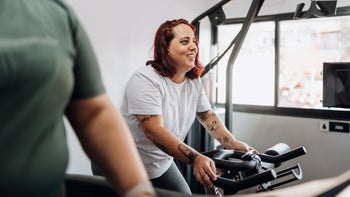
6 Low-Impact Exercises for Knee Arthritis
Key takeaways:
Osteoarthritis –– a condition that wears down bones and cartilage in joints –– often affects the knees. It causes pain, stiffness, and swelling.
Exercises for knee arthritis may increase leg flexibility, strengthen the knees and hips, and ease pain.
Generally, exercise is safe and beneficial for people with knee arthritis. But high-impact activities –– such as running, jumping, and lunging –– can aggravate symptoms. It's best to avoid these moves until you build leg strength and stability.
Table of contents

Arthritis is a common musculoskeletal condition that affects 24% of adults in the U.S. While there are many types, osteoarthritis is the most common. This degenerative condition wears down the cartilage in joints and surrounding bones. It often affects the knees, causing joint pain, stiffness, and inflammation. These symptoms can make it difficult to move around and complete your daily activities.
You might think exercising worsens knee arthritis. But targeted stretching and strengthening exercises can help improve your symptoms. All you need are your healthcare provider's OK and helpful tips to get started.
What are the best exercises for knee arthritis?
Working out might be the last thing on your mind when you have knee arthritis. But, when done carefully, exercises for knee arthritis can help alleviate symptoms. A complete routine for knee osteoarthritis should include:
Stretches: Joint inflammation can make your knees stiff. Stretches can relax tight muscles and increase flexibility, allowing more fluid movement.
Strengthening exercises: Inflammation can also cause knee joint pain, especially when standing, walking, or bending. Targeted strengthening exercises can help support and stabilize your knees. Stronger muscles may relieve pressure from painful joints and make everyday activities easier.
Save over 40% on Qsymia with GoodRx
Discover the once daily Qsymia for weight management. Qsymia is for adults and children 12-17 in combination with a healthy diet and regular exercise.

Here are 6 stretches and exercises to help you get started.
1. Standing quadriceps stretch
As the name suggests, the standing quadriceps stretch works the quadriceps muscles –– a group of four muscles on the front of your thighs. Increased quadriceps flexibility allows you to bend your knee further with less discomfort.
Step 1: Stand tall with your back straight. Hold the back of a stable chair for balance.
Step 2: Bend one knee, moving your heel toward your butt.
Step 3: Grasp your ankle to gently move your foot closer to your butt, feeling the stretch along the front of your thigh. You can squeeze your glute to push your hip forward and deepen the stretch.
Step 4: Hold for 30 seconds. Then repeat on the other side.
Step 5: Perform the stretch 3 to 5 times on each side.
2. Standing hamstring stretch
The standing hamstring stretch lengthens the muscles on the back of your thighs. Hamstring stretches may increase flexibility and range of motion for better, pain-free movement.
Step 1: Stand upright in front of an exercise block. Put your heel on the block and point your toes toward the ceiling. Keep your leg straight and your knee extended.
Step 2: Hinge at the hips to lean forward, slowly bringing your chest toward one leg. Keep your back straight and your leg extended as you bend forward.
Step 3: Hold for 30 seconds, feeling the stretch in the back of your extended leg behind your knee.
Step 4: Repeat on the other side.
Step 5: Perform the stretch 3 to 5 times on each side.
3. Knee extension
You can isolate your quadriceps muscles with the seated knee extension. This group of muscles helps extend and stabilize the knee. Having strong quadriceps has been shown to ease pressure on your joints and relieve knee pain.
Step 1: Sit in a chair with your back straight and feet flat on the floor.
Step 2: Extend one leg in front of you, and point your toes toward the ceiling. Squeeze your quadriceps muscles in the front of your thigh to keep your knee locked and straight.
Step 3: Hold this position for 5 to 10 seconds, then relax.
Step 4: Complete 20 repetitions on each side.
Read more like this
Explore these related articles, suggested for readers like you.
4. Straight leg raise
Straight leg raises help with quadricep muscle strength and control, increasing your ability to keep your knee stable with movement.
Step 1: Lie on your back. Bend one leg, placing your foot flat on the floor. Keep the other leg extended with your foot flexed and toes pointed toward the ceiling.
Step 2: Squeeze or contract the quadriceps muscle of your extended leg to keep your knee locked and straight.
Step 3: Keep your knee locked as you slowly lift your extended leg. Raise your leg until your knee is level with your bent knee, then slowly lower your leg to the starting position.
Step 4: Complete 20 repetitions on each side.
5. Side-lying leg lift
The side-lying leg lift does double duty: It helps with quadriceps control while targeting the outer glutes at the sides of the hips. These muscles stabilize your hips and knees and keep your joints aligned.
Step 1: Lie on one side with your legs extended and your feet flexed. Keep your hips, knees, ankles, and feet stacked.
Step 2: Put your forearm flat on the floor or bend your arm and rest your head in your hand.
Step 3: Engage your core and raise your top leg, keeping your foot flexed and your hips aligned.
Step 4: Pause for 3 to 5 seconds before slowly lowering your leg to the starting position.
Step 5: Complete 20 repetitions on each side.
6. Bridge
With the bridge, you engage core and lower-body muscles, including the glutes, hamstrings, and hip adductors. The glutes are powerful hip muscles that can reduce pressure on your knees and allow your leg muscles to support more of your body weight.
Step 1: Lie on your back with your knees bent and your feet flat on the floor.
Step 2: Gently press your lower back toward the floor to engage your abs.
Step 3: Lift your hips without arching your back.
Step 4: Keep your core engaged by squeezing your glutes and drawing your belly button toward your spine.
Step 5: Hold the bridge for 5 to 10 seconds before slowly lowering your hips to the starting position.
Step 6: Complete 20 repetitions.
What exercises should you avoid with knee arthritis?
Exercising with knee arthritis is generally recommended, safe, and beneficial. But certain types of exercise should be avoided. High-impact activities that put a lot of stress on your knees can worsen knee joint pain and irritation. To help protect your joints while exercising with knee osteoarthritis, avoid or limit activities such as:
Running
Jumping
Stair climbing
Deep squatting and lunging
You may be able to resume these activities after your exercise routine has made your surrounding leg muscles stronger and better able to support your knee joints. Consider working with a physical therapist or personal trainer to create an exercise program that's right for you.
Tips to protect your knees during exercise
To exercise safely with knee arthritis, avoid putting too much stress on your joints. Follow practical tips when starting an exercise routine to protect your joints and keep your knees healthy and pain-free.
Start slowly. Too much activity too soon can stress any part of your body, especially with arthritis. When beginning any exercise routine, start slowly. Then, ease into more exercise. This will give your body time to adjust to increased activity.
Reduce weight bearing. Standing and bearing weight through your legs can increase pressure on arthritic knees. Starting with non-weight-bearing exercises –– such as those that allow you to lie down or sit in a chair –– can help reduce pressure and discomfort.
Start with low-impact exercise. Low-impact exercises are a great way to stay active with joint-friendly movements. Activities such as walking, swimming, cycling on a stationary bike, and practicing tai chi or yoga can help you get a great workout without putting too much pressure or friction on your joints. As your symptoms improve, you can talk to your provider about doing higher-impact activities such as running.
Prioritize your form. Learning proper exercise form is key to reducing the risk of injuries. Practice performing exercises slowly and with control to help maximize your strength and coordination.
Adjust your routine when necessary. Pay attention to how different exercises affect your knee osteoarthritis symptoms. And adjust your routine accordingly. For example, if running worsens your knee pain, opt for power walking. Or consider pool exercises to help manage joint pain and stiffness.
The bottom line
Exercise is key for managing knee arthritis, but not all moves affect every person with knee arthritis the same way. Quadriceps and hamstring stretches may increase flexibility and range of motion. Strengthening exercises for the quadriceps and glutes can improve strength, stabilize the knees, and reduce pain.
You may need to avoid hip-impact activities –– such as running, jumping, or deep squatting –– to decrease pressure and knee irritation. Talk to your healthcare provider and start slowly with new exercises for knee arthritis. Try to reduce or avoid weight-bearing exercises, keeping your impact low. And always listen to your body, adjusting your routine as necessary.
Why trust our experts?



References
[P]rehab. (2019). Straight leg raise - Knee rehab [video]. YouTube.
Al-Johani, A. H., et al. (2014). Comparative study of hamstring and quadriceps strengthening treatments in the management of knee osteoarthritis. Journal of Physical Therapy Science.
American Council on Exercise. (n.d.). Glute bridge exercise.
Centers for Disease Control and Prevention. (2021). Arthritis.
Fransen, M., et al. (2015). Exercise for osteoarthritis of the knee. Cochrane Database of Systematic Reviews.
Gay, C., et al. (2016). Educating patients about the benefits of physical activity and exercise for their hip and knee osteoarthritis. Systematic literature review. Annals of Physical and Rehabilitation Medicine.
Institute for Quality and Efficiency in Health Care. (2019). Osteoarthritis of the knee: What can I do to strengthen my knees?
Mora, J. C., et al. (2018). Knee osteoarthritis: Pathophysiology and current treatment modalities. Journal of Pain Research.
OrthoInfo. (2021). Managing arthritis pain with exercise. American Academy of Orthopaedic Surgeons.





























